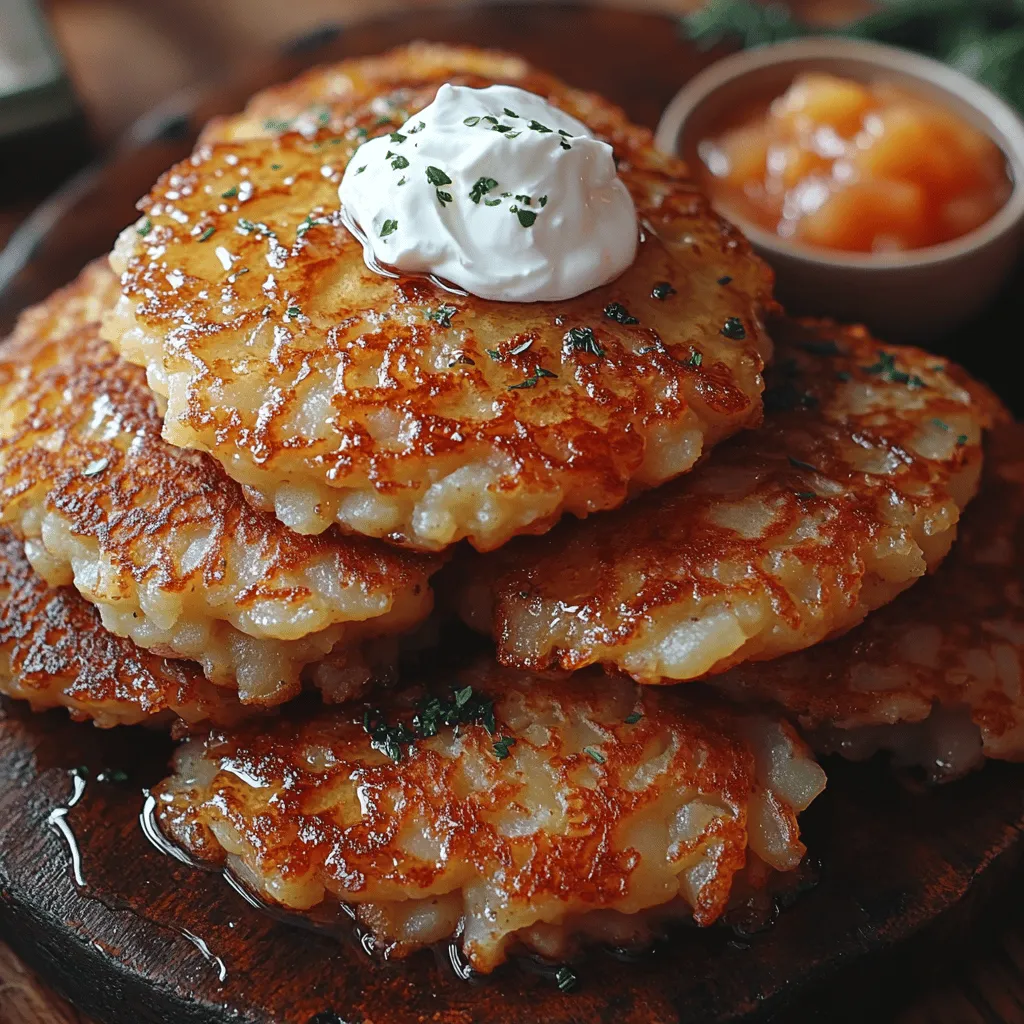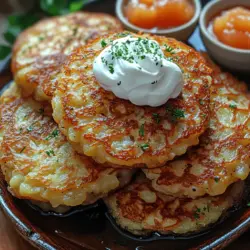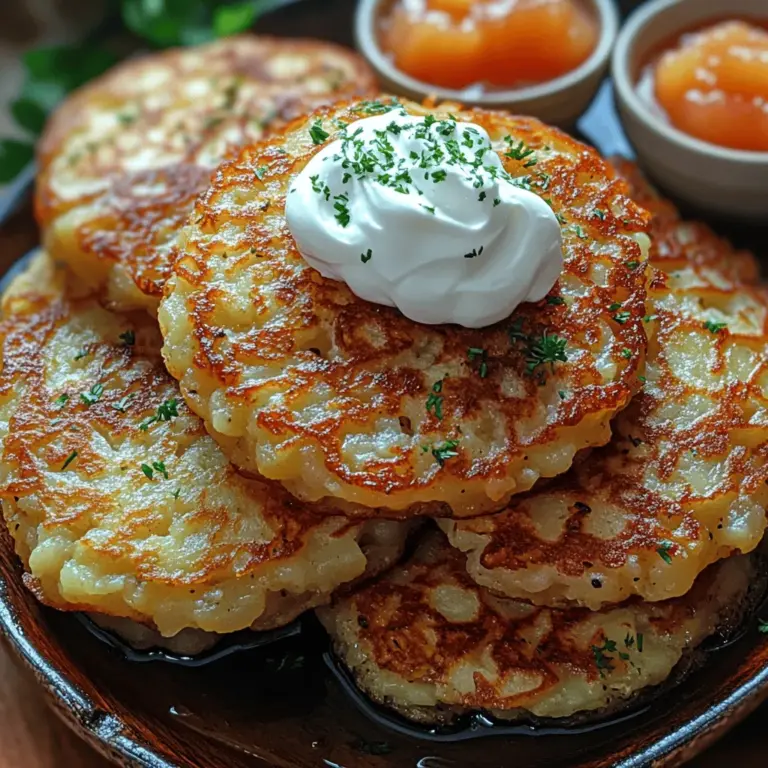Introduction
Crispy German Potato Pancakes, also known as Reibekuchen or Kartoffelpuffer, are more than just a dish; they are a culinary tradition steeped in history and comfort. With a golden brown, crispy exterior and a tender, flavorful interior, these pancakes are not only a staple in German cuisine, but they also bring warmth and nostalgia to countless households. Whether served as a satisfying breakfast, a delightful side dish for lunch, or a savory snack during dinner, the versatility of potato pancakes makes them a beloved choice for any occasion.
In this article, we will embark on a culinary journey, exploring the art of making these delightful potato pancakes from scratch. We’ll start by understanding the cultural significance and history behind this dish, ensuring you appreciate each bite. Then, we’ll break down the essential ingredients that contribute to their crispy perfection. Finally, we’ll provide detailed, step-by-step instructions to guide you through the entire cooking process, making it easy for you to master this delicious tradition.
Understanding the Essence of German Potato Pancakes
The origins of German Potato Pancakes can be traced back to the 16th century, where they first appeared as a way to utilize leftover potatoes and other ingredients. As potatoes became a staple in German agriculture, dishes like Reibekuchen gained popularity, especially in rural communities. This dish is not just a meal; it represents resourcefulness, creativity, and the agricultural heritage of Germany.
The Origins of Potato Pancakes
Reibekuchen, or Kartoffelpuffer, translates to “grated cake,” which perfectly describes the method of preparation. Traditionally, the potatoes are grated and mixed with other ingredients to create a batter, which is then fried until golden brown. The use of potatoes in this manner allowed families to stretch their ingredients, especially during the long winter months when fresh produce was scarce.
Regional Variations and Traditions
Throughout Germany, there are many regional variations of potato pancakes. In the Rhineland, for example, they are often served with applesauce, while in other areas, they may be accompanied by sour cream or even smoked salmon. Each region has its own unique twist, influenced by local ingredients and culinary traditions. In fact, during the holiday season, potato pancakes are often prepared for festive gatherings, symbolizing warmth and togetherness.
Why They Are a Beloved Comfort Food
What makes Crispy German Potato Pancakes such a cherished comfort food is their ability to evoke feelings of nostalgia. Many families have their own cherished recipes passed down through generations, each with its unique flavor profile and cooking method. The simple yet satisfying taste of these pancakes can transport you back to family gatherings and holiday celebrations, making them more than just food; they are a connection to family history and cultural identity.
Ingredients for Crispy Perfection
Creating the perfect Crispy German Potato Pancakes starts with selecting the right ingredients. Each component plays a crucial role in achieving that delightful texture and flavor that makes these pancakes so irresistible.
Overview of Russet Potatoes
When it comes to potato selection, russet potatoes are the star of the show. Known for their high starch content, russets yield a crispy exterior while maintaining a fluffy interior. This balance is essential for achieving that signature texture that makes potato pancakes so enjoyable. The starch in the potatoes helps bind the ingredients together, ensuring that the pancakes hold their shape during frying.
The Importance of Fresh Onion
Fresh onion is another key ingredient that contributes to the flavor profile of these pancakes. Its natural sweetness complements the earthy taste of the potatoes, adding depth and complexity. When grated, onions release their juices, which enhance the batter’s moisture and flavor. For the best results, opt for yellow onions, as they provide a balanced taste that works harmoniously with the potatoes.
A Closer Look at the Binding Agents: Egg and Flour
Eggs and flour serve as binding agents in the pancake batter, ensuring that the pancakes stay intact during cooking. The egg adds richness and helps to create a cohesive mixture, while flour provides structure. It’s important to use just the right amount; too much flour can result in dense pancakes, while too little can cause them to fall apart. A light dusting of flour, just enough to hold the mixture together, is ideal for achieving that perfect texture.
Seasoning Essentials: Salt, Pepper, and Optional Nutmeg
Seasoning is critical in enhancing the overall flavor of your potato pancakes. A pinch of salt and a dash of freshly ground black pepper are essential for bringing out the natural flavors of the ingredients. For those who want to elevate the taste even further, consider adding a hint of nutmeg. This warm spice adds a subtle depth and a touch of complexity that can transform your pancakes from ordinary to extraordinary.
Choosing the Right Type of Oil for Frying
The type of oil you use for frying can greatly affect the final product. A high smoke point oil, such as canola or vegetable oil, is ideal for frying potato pancakes. These oils can withstand high temperatures without burning, ensuring that your pancakes develop a crispy, golden crust. Additionally, using a combination of butter and oil can enhance the flavor while still providing the necessary frying properties.
Step-by-Step Guide to Making Crispy German Potato Pancakes
Now that we’ve explored the cultural significance and the essential ingredients, it’s time to roll up our sleeves and get cooking. Here is a detailed, step-by-step guide to making your own Crispy German Potato Pancakes.
Step 1: Gather Your Ingredients
Before you start, ensure you have all the necessary ingredients measured and ready to go:
– 4 medium russet potatoes
– 1 medium yellow onion
– 1 large egg
– 1/4 cup all-purpose flour
– Salt and pepper to taste
– A pinch of nutmeg (optional)
– Oil for frying (canola or vegetable oil)
Step 2: Prepare the Potatoes
Begin by peeling the russet potatoes. Once peeled, grate them using a box grater or a food processor fitted with a grating attachment. As you grate, place the grated potatoes into a large bowl of cold water to prevent oxidation and browning. This step helps maintain the potatoes’ vibrant color and freshness.
Step 3: Grate the Onion
Next, peel and grate the onion. You can use the same box grater or food processor for this step. Once grated, add the onion to the bowl of grated potatoes. The mixture of onion and potatoes will create a flavorful base for your pancakes.
Step 4: Drain Excess Moisture
After grating, it’s crucial to drain excess moisture from the potato and onion mixture. This step is vital for achieving crispiness. Use a fine mesh sieve or a clean kitchen towel to squeeze out as much liquid as possible. The drier the mixture, the better the texture of your pancakes will be.
Step 5: Mix the Batter
In a separate bowl, beat the egg and add it to the drained potato and onion mixture. Sprinkle in the flour, salt, pepper, and nutmeg (if using). Mix everything together until well combined. The mixture should hold together but still be somewhat loose. Adjust the flour as necessary to achieve the right consistency.
Step 6: Heat the Oil
In a large skillet, heat about 1/4 inch of oil over medium-high heat. To test if the oil is hot enough, you can drop a small spoonful of the batter into the oil; if it sizzles immediately, you’re ready to fry.
Step 7: Fry the Pancakes
Using a spoon or your hands, scoop out a portion of the batter and carefully drop it into the hot oil. Flatten the mixture slightly with the back of the spoon to form a pancake shape. Fry for about 3-4 minutes on each side, or until golden brown and crispy. Avoid overcrowding the pan; this ensures even cooking and prevents the temperature from dropping too much.
Step 8: Drain and Serve
Once cooked, transfer the pancakes to a paper towel-lined plate to drain any excess oil. Serve them warm, accompanied by your choice of applesauce, sour cream, or even a sprinkle of fresh herbs for an added touch.
In this article, we delved into the history and cultural significance of Crispy German Potato Pancakes, explored the essential ingredients that contribute to their unique flavor and texture, and provided a detailed step-by-step guide to crafting these delightful morsels. By embracing this traditional recipe, you’ll not only enjoy a delicious meal but also connect with a rich culinary heritage that has stood the test of time. As we continue, we will explore serving suggestions, variations, and tips for achieving the best results with your potato pancakes, ensuring that your culinary journey is both rewarding and enjoyable.

Preparing the Potatoes: Techniques for Grating and Moisture Removal
To create perfectly crispy German potato pancakes, the foundation begins with preparing the potatoes correctly. Start with starchy potatoes—Russets or Yukon Golds work beautifully due to their high starch content, which contributes to a fluffier texture. Here’s how to prepare them:
1. Peeling: Begin by peeling the potatoes using a vegetable peeler. This step is crucial because the skin can introduce a tough texture that detracts from the pancake’s overall mouthfeel.
2. Grating: Use a box grater or a food processor fitted with a grating attachment to shred the potatoes finely. A fine grate will yield a pancake with a tender interior, while a coarse grate offers a heartier crunch. If you prefer a more traditional texture, opt for the coarse side of the grater.
3. Moisture Removal: After grating, the potatoes will release a significant amount of moisture. This excess moisture can lead to soggy pancakes. To remove it:
– Place the grated potatoes in a clean kitchen towel or cheesecloth, twist the cloth, and squeeze out the liquid.
– Alternatively, you can use a fine-mesh sieve to drain the liquid. The goal is to get the potatoes as dry as possible without losing any of their wonderful flavor.
By properly preparing the potatoes in this manner, you set the stage for a crispy, delicious pancake that will be the highlight of your meal.
Mixing the Ingredients: Achieving the Perfect Batter Consistency
Once the potatoes are prepped, it’s time to mix the ingredients to create the batter. The right balance of ingredients will ensure that your pancakes bind together nicely while retaining their crispiness.
1. Base Ingredients: In a large bowl, combine the grated potatoes with finely chopped onions. Onions add a depth of flavor that elevates the dish.
2. Binding Agents: Add one or two eggs, which act as a binder, helping the mixture hold together. If you’re looking for a vegetarian or vegan option, you can substitute the eggs with a flaxseed meal (1 tablespoon of flaxseed with 3 tablespoons of water, let it sit until it thickens).
3. Flour: Gradually stir in flour to the potato mixture. About ¼ to ½ cup of all-purpose flour should suffice, depending on the moisture content of your potatoes. The flour not only helps bind the ingredients but also contributes to the crispiness of the pancakes.
4. Seasoning: Don’t forget to season your batter with salt and pepper to enhance the flavors. Fresh herbs like chives or parsley can also be added for an aromatic touch.
Mix the ingredients until just combined. Overmixing can lead to a gummy texture, so be gentle. The batter should be moist but not overly wet; it should hold its shape when scooped.
Heating the Oil: The Ideal Temperature for Frying
Frying is a crucial step that can make or break your potato pancakes. The right oil temperature ensures that the pancakes cook evenly and achieve that desirable crispy exterior.
1. Choosing the Oil: Use a neutral oil with a high smoke point, such as canola or vegetable oil. This allows for a good frying temperature without burning.
2. Preheating the Oil: In a large skillet or frying pan, pour enough oil to cover the bottom of the pan generously, about ¼ inch deep. Heat the oil over medium-high heat.
3. Testing the Temperature: To check if the oil is hot enough, drop a small spoonful of batter into the oil. If it sizzles and bubbles immediately, the oil is ready. If the batter sinks without bubbling, the oil is not hot enough, and if it smokes, the oil is too hot.
Maintaining the right frying temperature is essential. If the oil is too cool, the pancakes will absorb more oil and become greasy. If it’s too hot, they will burn on the outside while remaining raw inside.
Forming and Frying: Tips for Shaping the Pancakes and Achieving Even Cooking
With the oil at the right temperature, it’s time to form and fry the pancakes. This step requires a bit of technique to ensure they cook evenly and develop that signature crispiness.
1. Shaping the Pancakes: Using a spoon or your hands, scoop a portion of the batter (about ¼ cup) and gently flatten it into a round disc about ½ inch thick. Avoid pressing too hard, as this can compact the mixture, reducing its fluffiness.
2. Frying the Pancakes: Carefully place the formed pancakes into the hot oil, leaving enough space between each pancake to allow them to cook evenly. You may need to fry them in batches, depending on the size of your skillet.
3. Cooking Time: Fry each pancake for about 3-4 minutes on one side until golden brown, then flip and cook the other side for an additional 3-4 minutes. Keep an eye on them to prevent burning, adjusting the heat as necessary.
4. Achieving Even Cooking: To ensure even cooking, you can gently shake the pan occasionally. This movement helps the pancakes cook uniformly, creating that coveted crispy texture all around.
Draining Excess Oil: Importance of Proper Draining for Texture
After frying, the next step is crucial for maintaining the texture of your crispy German potato pancakes. Proper draining of excess oil will prevent them from becoming soggy.
1. Using a Draining Rack: Place a wire rack over a baking sheet or line a plate with paper towels. This will allow the excess oil to drip away while keeping the pancakes crisp.
2. Transferring the Pancakes: Once fried, carefully transfer the pancakes to the rack or plate, ensuring they’re not stacked on top of each other. Stacking can trap steam and moisture, leading to sogginess.
3. Optional Seasoning: While still hot, you can sprinkle a little extra salt on top for added flavor. This step is particularly important as it enhances the taste right before serving.
Serving Suggestions and Pairings
Crispy German potato pancakes are incredibly versatile and can be served with a variety of accompaniments that enhance their delightful flavor.
Traditional Toppings: The Classic Sour Cream
One of the most popular ways to enjoy potato pancakes is with a generous dollop of sour cream. The creaminess of sour cream balances the crispy texture of the pancakes beautifully, providing a rich and tangy contrast. For an extra layer of flavor, consider adding fresh herbs like dill or chives to the sour cream.
Exploring the Sweetness of Applesauce as an Accompaniment
For those who enjoy a sweet and savory combination, applesauce is a fantastic accompaniment. The natural sweetness and slight tartness of applesauce complement the savory flavor of the pancakes, creating a well-rounded dish. This pairing is especially popular in German cuisine and brings a delightful contrast to each bite.
Other Creative Serving Ideas: Fresh Herbs, Smoked Salmon, or Sautéed Vegetables
Beyond the traditional toppings, there are numerous creative ways to serve crispy potato pancakes:
– Fresh Herbs: Garnish with fresh herbs such as parsley, chives, or dill for an aromatic touch that brightens up the dish.
– Smoked Salmon: For a luxurious twist, top the pancakes with smoked salmon and a smear of cream cheese. This rich combination makes for an elegant brunch option.
– Sautéed Vegetables: Serve alongside sautéed vegetables like spinach or bell peppers for added nutrition and color.
Nutritional Insights
Understanding the nutritional profile of your crispy German potato pancakes can help you appreciate their place in a balanced diet.
Caloric Content and Nutritional Breakdown Per Serving
A typical serving of potato pancakes (about two pancakes) contains approximately 250-300 calories, depending on the ingredients used and the amount of oil absorbed during frying. The pancakes provide a good source of carbohydrates and some protein from the eggs and flour.
Potential Health Benefits of Using Fresh Ingredients
Utilizing fresh ingredients can enhance the nutritional value of your pancakes. Potatoes are a great source of vitamins C and B6, potassium, and dietary fiber. Adding fresh herbs and vegetables not only boosts flavor but also increases the vitamin and antioxidant content of the dish.
Vegetarian and Gluten-Free Adaptations of the Recipe
The original recipe is naturally vegetarian, but for those with gluten sensitivities, consider using gluten-free flour or alternative binders like chickpea flour. This adaptation allows everyone to enjoy this delightful dish without compromising on flavor or texture.
Conclusion
Crispy German potato pancakes are more than just a dish; they are a culinary celebration of tradition and flavor. With this comprehensive guide, you can bring this classic recipe into your kitchen, creating a delightful experience for yourself and your loved ones. Embrace the simplicity and satisfaction of making these pancakes from scratch, and enjoy the rich history and taste that each bite brings. Enjoy the journey of creating this crispy delight! Whether served with traditional accompaniments or innovative pairings, these potato pancakes are sure to impress and satisfy.

